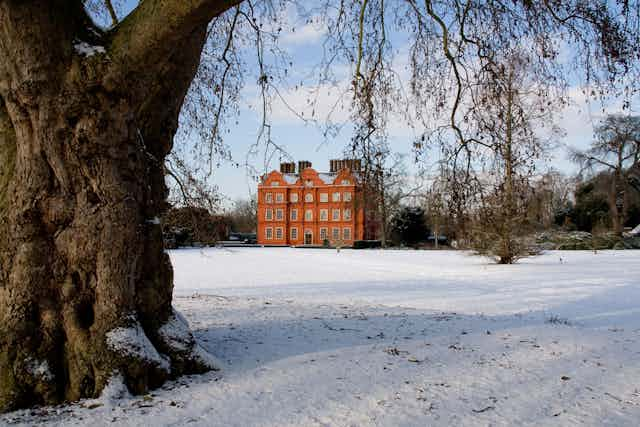Picture the scene: a cosy but grand rural retreat. A long mahogany table is dressed for Christmas with evergreen foliage. Flickering flames in a huge stone fireplace reflect off crystal chandeliers, gold candelabras, and the jewelled tiaras of ladies sitting down to dine. A parade of footmen arrives carrying 21 different dishes – sweet and savoury – which they carefully place along the length of the table.
Thanks to a number of menu books from the time – kept by the kitchens at Kew Palace to monitor the royal household’s spending – we know precisely what dishes the Kew cooks created to feed not just the royal family, but every member of this household.
These wonderful books form the basis of a study by myself and historians Rachel Rich, Adam Crymble and Lisa Smith that tracks every meal served at Kew Palace, occasional home and rural retreat of George III and his family, from 1788 to 1801. During this period, the kitchens at Kew served 22,655 dishes to more than 50 different groups of diners, each recorded in detail by the clerks of the kitchen.

Food fit for a king
On Christmas Day 1788, the clerk carefully wrote exactly what “their Majesties” – King George III (1738-1820) and his wife Queen Charlotte (1744-1818) – had been served for Christmas dinner. At the centre of the feast was a roasted wild turkey, caught in nearby Richmond Park, a large Christmas pie, and 18lb of roast beef. Turkey was a particular treat, only served occasionally and usually at Christmas.
More roasted meat supplemented this very recognisable Christmas fare: Richmond pork, a pheasant, two wild ducks, and nine cutlets of mutton. Like many of their subjects, the king and his family were also served brawn – a type of terrine made from calves or pigs’ heads – and a plate of mince pies, which bridged sweet and savoury with the inclusion of beef along with the dried fruit and spices.
Fish and vegetable flavours came in the form of the king’s favourite: spinach, stewed endive and dishes of sole and pike. Sweet tooths were satisfied by the provision of an apple pie, seven small pastries (probably bought from a local baker) and an entertainingly wobbly jelly. This meal was served à la française, meaning that it was all placed on the table at once, and diners were expected to eat the dishes closest to them.
This food was created not just to celebrate Christmas but to tempt reluctant diners to eat. In December 1788, the King was suffering from the “madness” that would eventually see him replaced by his son, the Prince Regent, in 1811. Queen Charlotte was unsurprisingly distressed after several disturbing encounters with her previously devoted husband, and was not eating.
Health, class and empire
Food in the 18th century was closely linked to physical health, mental health, and to bigger ideas of nationality and patriotism. The adage “you are what you eat” was a matter of medical fact – British constitutions required British food to keep them hale and hearty.

As early as the 16th century, travellers to Britain were commenting on the amount of beef eaten by the British, and by the 18th century roast beef, mustard and horseradish was central to British identities. Roast beef was believed to make Britons strong and healthy, and seen as reflective of a national character: plain-speaking and honest.
The 18th century also saw the rapid expansion of British imperial interests across the world, a process that introduced many global flavours to British tables. The spices – mace, nutmeg and cloves – in the mince pies served to the royal household had been familiar to British palates for many centuries, but became more affordable and accessible to ordinary people during this period.
The centrepiece of George III’s Christmas table, the turkey, originated in America but had been assimilated into British diets alongside potatoes, tomatoes and pineapples.
The right food could restore and revive sick bodies, but too much food or the wrong type of food had the opposite effect. Social class also dictated the type of food that you should eat. Royal bodies, used to fine food delicately served by the best chefs, would get ill if they ate like their housemaids and grooms.

Christmas dinner below stairs
The Kew cooks were highly attuned to these different uses and meanings of food. This meant that they didn’t have to cook just one Christmas meal, but several. To maintain social distinctions, they could not replicate the food being served to the king, but could use similar ingredients to reduce the amount of work required to feed the entire household a Christmas meal.
The upper servants were generally men of high social rank, and their food reflected this. They were served turkey with an oyster sauce, roast pork, beef, mutton and partridges, all rounded off with mince pies and blancmange. This was a simplified version of the royal table, but still luxurious.
Feeding the lower servants was much easier: the footmen, grooms and dress servants received a traditional meal of roast beef and plum pudding (now known as Christmas cake). Then, having roasted 164lb of beef, five turkeys and vast volumes of mince pies and plum pudding over a 12-hour period, the cooks at Kew finally settled down to their own Christmas meal.
As befitted their station, they feasted on the beef and plumb pudding they had served their peers – but there were perks to working in the kitchen. The general staff were also served roast and boiled pork, while the clerk of the kitchen tucked into a boiled turkey and mince pies.
It’s often thought the Victorians invented the modern Christmas with their clever innovations, such as crackers and Christmas cards. But we really have the Georgians to thank for our Christmas dinner.

